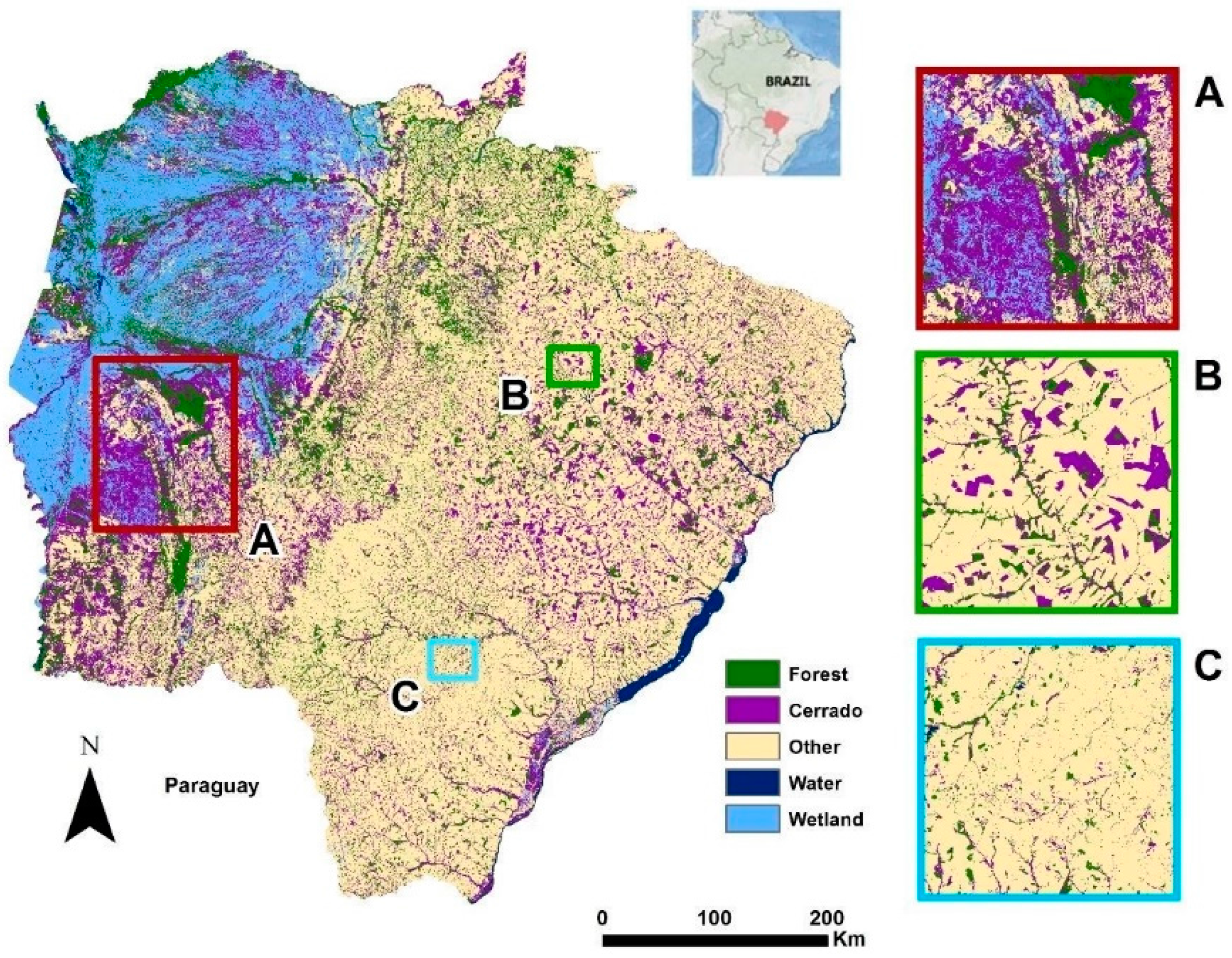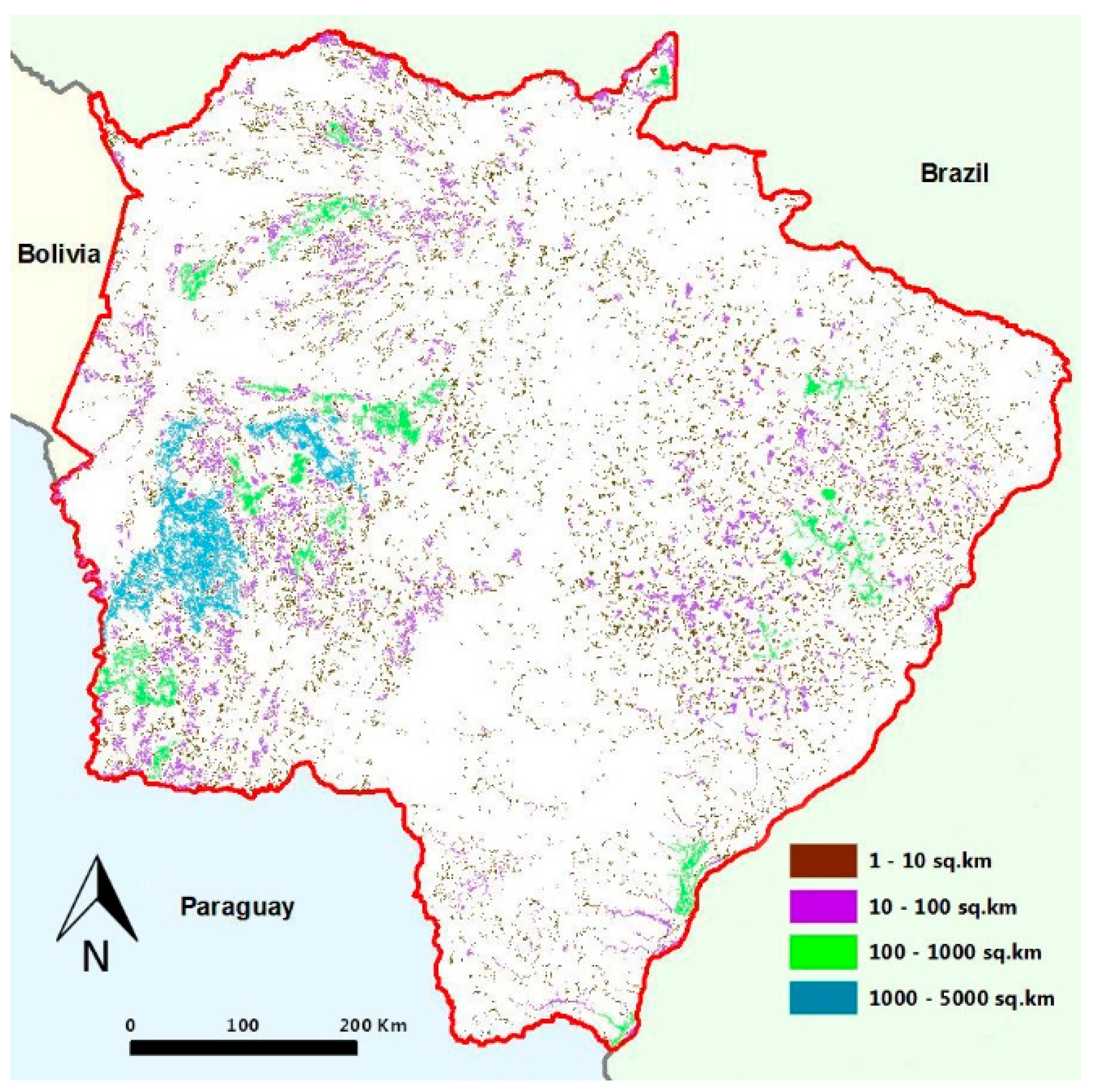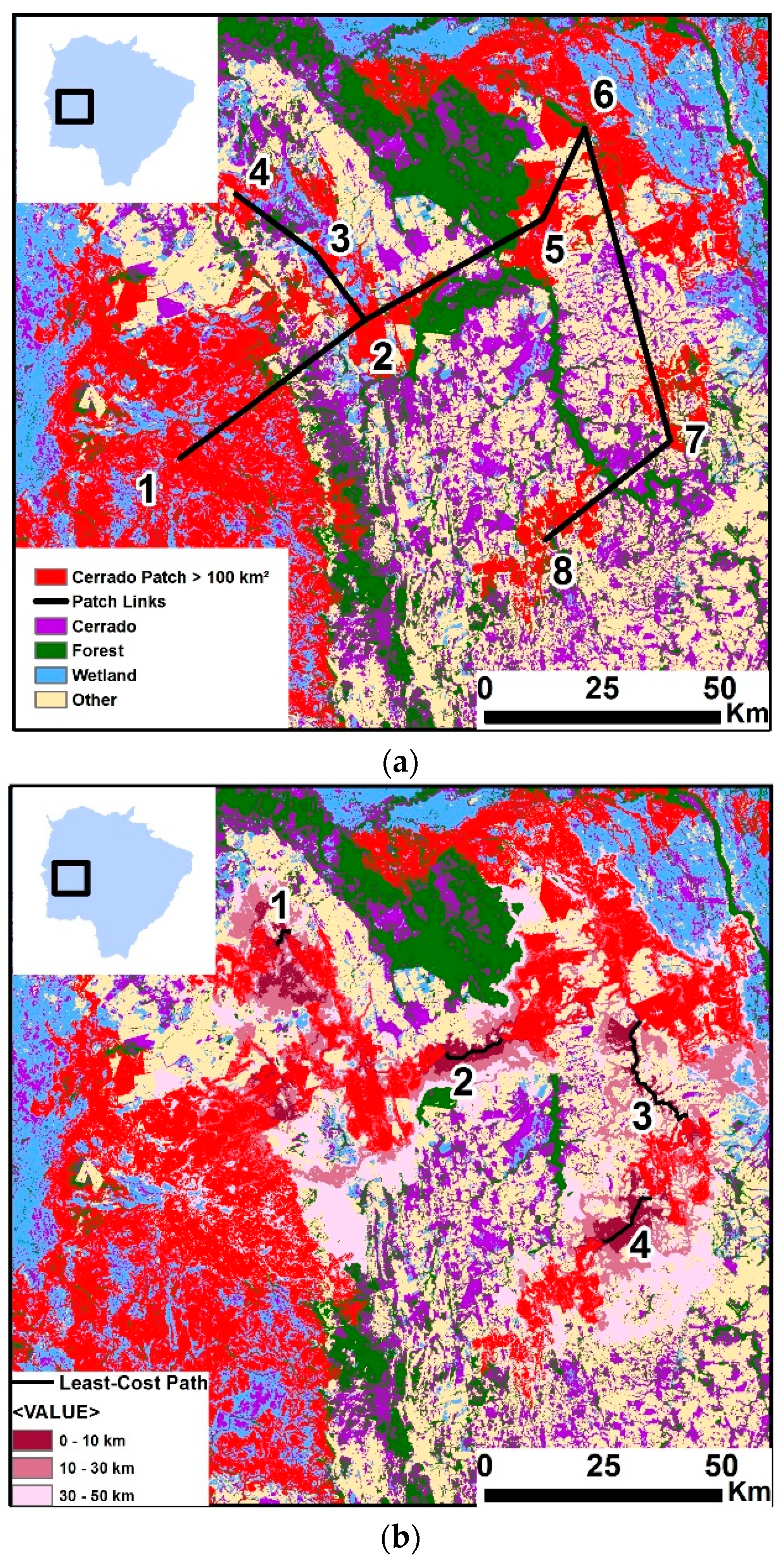Using Remote Sensing and Random Forest to Assess the Conservation Status of Critical Cerrado Habitats in Mato Grosso do Sul, Brazil
Abstract
:1. Introduction
2. Materials and Methods
2.1. Study Area
2.2. Mapping Definitions and Thresholds for the Cerrado
2.3. Remote Sensing Analysis
2.4. Accuracy Assessment
2.5. Measuring Fragmentation
2.6. Habitat Connectivity
3. Results
4. Discussion
5. Conclusions
Acknowledgments
Author Contributions
Conflicts of Interest
Abbreviations
| MDPI | Multidisciplinary Digital Publishing Institute |
| K | Kappa Coefficient |
| RF | Random Forest |
| NDVI | Normalized Difference Vegetation Index |
| MODIS | Moderate Resolution Imaging Spectroradiometer |
| OOB | Out-of-bag |
| ESRI | Environmental Systems Research Institute |
| CI | Conservation International |
| FUNAI | National Indian Foundation |
| ACIRK | Kadiwéu Reserve Indigenous Communities Association |
| IUCN | International Union for Conservation of Nature |
| SNUC | National System of Protected Areas |
Appendix A
| Date | Path | Row |
|---|---|---|
| 08 August 2014 | 222 | 074 |
| 30 July 2014 | 223 | 073 |
| 30 July 2014 | 223 | 074 |
| 30 July 2014 | 223 | 075 |
| 30 July 2014 | 223 | 076 |
| 06 August 2014 | 224 | 073 |
| 06 August 2014 | 224 | 074 |
| 06 August 2014 | 224 | 075 |
| 06 August 2014 | 224 | 076 |
| 06 August 2014 | 224 | 077 |
| 28 July 2014 | 225 | 072 |
| 29 August 2014 | 225 | 073 |
| 16 October 2014 * | 225 | 073 |
| 29 August 2014 | 225 | 074 |
| 21 Sepember 2014 * | 225 | 074 |
| 29 August 2014 | 225 | 075 |
| 29 August 2014 | 225 | 076 |
| 04 August 2014 | 226 | 072 |
| 04 August 2014 | 226 | 073 |
| 21 Sepember 2014 | 226 | 074 |
| 20 August 2014 | 226 | 075 |
| 11 August 2014 | 227 | 072 |
| 11 August 2014 | 227 | 073 |
| 11 August 2014 | 227 | 074 |
| 11 August 2014 | 227 | 075 |
References
- Klink, C.A.; Machado, R.B. Conservation of the Brazilian Cerrado. Conserv. Biol. 2005, 19, 707–713. [Google Scholar] [CrossRef]
- Müller, H.; Rufin, P.; Griffiths, P.; Siqueira, A.J.B.; Hostert, P. Mining dense Landsat time series for separating cropland and pasture in a heterogeneous Brazilian savanna landscape. Remote Sens. Environ. 2015, 156, 490–499. [Google Scholar] [CrossRef]
- Brannstrom, C.; Jepson, W.; Filippi, A.M.; Redo, D.; Xu, Z.; Ganesh, S. Land change in the Brazilian Savanna (Cerrado), 1986–2002: Comparative analysis and implications for land-use policy. Land Use Policy 2008, 25, 579–595. [Google Scholar] [CrossRef]
- De Castro, E.C. Aerial photo land cover classification of cerrado physiognomies: Detailed or accurate maps. In Proceedings of the 12th Simpósio Brasileiro de Sensoriamento Remoto, Goiânia, Brazil, 16–21 April 2005; INPE: São Paulo, Brazil, 2005; pp. 1175–1181. [Google Scholar]
- Beuchle, R.; Grecchi, R.C.; Shimabukuro, Y.E.; Seliger, R.; Eva, H.D.; Sano, E.; Achard, F. Land cover changes in the Brazilian Cerrado and Caatinga biomes from 1990 to 2010 based on a systematic remote sampling approach. Appl. Geogr. 2015, 58, 116–127. [Google Scholar] [CrossRef]
- Leimgruber, P.; Delion, M.; Songer, M. The uncertainty in mapping seasonally dry tropical forests in Asia. In The Ecology and Conservation of Seasonally Dry Forests in Asia; McShea, W.J., Davies, S.J., Bhumpakphan, N., Eds.; Smithsonian Institution Scholarly Press: Washington, DC, USA, 2011; Volume 1, pp. 59–74. [Google Scholar]
- Jung, M.; Henkel, K.; Herold, M.; Churkina, G. Exploiting synergies of global land cover products for carbon cycle monitoring. Remote Sens. Environ. 2006, 101, 534–553. [Google Scholar] [CrossRef]
- Breiman, L. Random forests. Mach. Learn. 2001, 45, 5–32. [Google Scholar] [CrossRef]
- Pal, M. Random Forest classifier for remote sensing classification. Int. J. Remote Sens. 2005, 26, 217–222. [Google Scholar] [CrossRef]
- Chan, J.C.-W.; Paelinckx, D. Evaluation of Random Forest and Adaboost tree-based ensemble classification and spectral band selection for ecotope mapping using airborne hyperspectral imagery. Remote Sens. Environ. 2008, 112, 2999–3011. [Google Scholar] [CrossRef]
- Horning, N. Random forests: An algorithm for image classification and generation of continuous fields data sets. In Proceedings of the International Conference on Geoinformatics for Spatial Infrastructure Development in Earth and Allied Sciences, Hanoi, Vietnam, 9–11 December 2010.
- Prasad, A.M.; Iverson, L.R.; Liaw, A. Newer classification and regression tree techniques: Bagging and random forests for ecological prediction. Ecosystems 2006, 9, 181–199. [Google Scholar] [CrossRef]
- Chakraborty, A.; Joshi, P.K. Comparing different classification approaches for mapping forest types in the complex Himalayan landscape. In Proceedings of the ISPRS TC 8th International Symposium on Operational Remote Sensing Applications: Opportunities, Progress and Challenges, Hyderabad, India, 9–12 December 2014.
- Li, C.; Wang, J.; Wang, L.; Hu, L.; Gong, P. Comparison of classification algorithms and training sample sizes in urban land classification with Landsat Thematic Mapper Imagery. Remote Sens. 2014, 6, 964–983. [Google Scholar] [CrossRef]
- Gislason, P.O.; Benediktsson, J.A.; Sveinsson, J.R. Random forests for land cover classification. Pattern Recognit. Lett. 2006, 27, 294–300. [Google Scholar] [CrossRef]
- Ratter, J.A.; Ribeiro, J.F.; Bridgewater, S. The Brazilian Cerrado vegetation and threats to its biodiversity. Ann. Bot. 1997, 80, 223–230. [Google Scholar] [CrossRef]
- Olson, D.M.; Dinerstein, E.; Wikramanayake, E.D.; Burgess, N.D.; Powell, G.V.N.; Underwood, E.C.; D’Amico, J.A.; Itoua, I.; Strand, H.E.; Morrison, J.C.; et al. Terrestrial ecoregions of the world: A new map of life on earth. BioScience 2001, 51, 933–938. [Google Scholar] [CrossRef]
- Nepstad, D.C.; Klink, C.; Uhl, C.; Viera, I.; LeFebvre, P.; Pedlowski, M.; Matricardi, E.; Negreiros, G.; Brown, I.; Amaral, E.; et al. Land-use in Amazonia and the Cerrado of Brazil. Ciênc. Cult. 1997, 49, 73–86. [Google Scholar]
- Eiten, G. The Cerrado vegetation of Brazil. Bot. Rev. 1972, 38, 201–341. [Google Scholar] [CrossRef]
- Mellor, A.; Haywood, A.; Stone, C.; Jones, S. The performance of random forests in an operational setting for large area sclerophyll forest classification. Remote Sens. 2013, 5, 2838–2856. [Google Scholar] [CrossRef]
- Walton, J.T. Subpixel urban land cover estimation: Comparing cubist, random forests, and support vector regression. Photogramm. Eng. Remote Sens. 2008, 74, 1213–1222. [Google Scholar] [CrossRef]
- Cutler, D.R.; Edwards, T.C., Jr.; Beard, K.H.; Cutler, A.; Hess, K.T.; Gibson, J.; Lawler, J.J. Random forests for classification in ecology. Ecology 2007, 88, 2783–2792. [Google Scholar] [CrossRef] [PubMed]
- Rodriguez-Galiano, V.F.; Ghimire, B.; Rogan, J.; Chica-Olmo, M.; Rigol-Sanchez, J.P. An assessment of the effectiveness of a random forest classifier for land-cover classification. ISPRS J. Photogramm. Remote Sens. 2012, 67, 93–104. [Google Scholar] [CrossRef]
- Horning, N.; Leutner, N.B.; Wegmann, M. Land cover and image classification approaches. In Remote Sensing and GIS for Ecologists; Wegmann, M., Leutner, B., Dech, S., Eds.; Pelagic Publishing: Exeter, UK, 2016; pp. 166–196. [Google Scholar]
- Lillesand, T.; Kiefer, R.W.; Chipman, J. Remote Sensing and Image Interpretation, 7th ed.; John Wiley & Sons, Inc.: Hoboken, NJ, USA, 2015. [Google Scholar]
- McGarigal, K.; Cushman, S.A.; Ene, E. FRAGSTATS v4: Spatial Pattern Analysis Program for Categorical Maps. Computer Software Program Produced by the Authors at the University of Massachusetts, Amhurst. Available online: http://www.umass.edu/landeco/research/fragstats/fragstats.html (accessed on 20 May 2016).
- McRae, B.H.; Kavanagh, D.M. Linkage Mapper Connectivity Analysis Software. Computer Software Program Produced by the Nature Conservancy in Seattle, WA, USA. Available online: http://www.circuitscape.org/linkagemapper (accessed on 16 April 2016).
- FUNAI—National Indian Foundation (Brazil). Available online: http://www.survivalinternational.org/about/funai (accessed on 4 May 2016).
- Da Silva, G.J. Os índios Kadiwéu na História: Problematizando fontes. In Proceedings of the XXIV Simpósio Nacional de História, São Leopoldo, Brazil, 26 June 2007; pp. 15–20.
- Conservation International. Semi-Annual Report 2002: Brazilian Biodiversity Corridor Implementation Program. Available online: http://pdf.usaid.gov/pdf_docs/PDACD214.pdf (accessed on 12 October 2015).
- Brooks, T.M.; Mittermeier, R.A.; da Fonseca, G.A.B.; Gerlach, J.; Hoffmann, M.; Lamoreux, J.F.; Mittermeier, C.G.; Pilgrim, J.D.; Rodrigues, A.S.L. Global biodiversity conservation priorities. Science 2006, 313, 58–61. [Google Scholar] [CrossRef] [PubMed]
- Butchart, S.H.M.; Walpole, M.; Collen, B.; van Strien, A.; Scharlemann, J.P.W.; Almond, R.E.A.; Baillie, J.E.M.; Bomhard, B.; Brown, C.; Bruno, J.; et al. Global biodiversity: Indicators of recent declines. Science 2010, 328, 1164–1168. [Google Scholar] [CrossRef] [PubMed]
- Geldmann, J.; Barnes, M.; Coad, L.; Craigie, I.D.; Hockings, M.; Burgess, N.D. Effectiveness of terrestrial protected areas in reducing habitat loss and population declines. Biol. Conserv. 2013, 161, 230–238. [Google Scholar] [CrossRef]
- Rodrigues, A.S.L.; Akçakaya, H.R.; Andelman, S.J.; Bakarr, M.I.; Boitani, L.; Brooks, T.M.; Chanson, J.S.; Fishpool, L.D.C.; da Fonseca, G.A.B.; Gaston, K.J.; et al. Global gap analysis: Priority regions for expanding the global protected-area network. Bioscience 2004, 54, 1092–1100. [Google Scholar] [CrossRef]
- Françoso, R.D.; Brandão, R.; Nogueira, C.C.; Salmona, Y.B.; Machado, R.B.; Colli, G.R. Habitat loss and the effectiveness of protected areas in the Cerrado Biodiversity Hotspot. Nat. Conserv. 2015, 13, 35–40. [Google Scholar] [CrossRef]
- IUCN Protected Areas Category Ia. Available online: https://www.iucn.org/about/work/programmes/gpap_home/gpap_quality/gpap_pacategories/gpap_cat1a/ (accessed on 12 October 2015).
- Rylands, A.B.; Brandon, K. Brazilian protected areas. Conserv. Biol. 2005, 19, 612–618. [Google Scholar] [CrossRef]
- Cavalcanti, R.B.; Joly, C.A. Biodiversity and conservation priorities in the Cerrado region. In The Cerrados of Brazil: Ecology and Natural History of a Neotropical Savanna; Oliveira, P.S., Marquis, R.J., Eds.; Columbia University Press: New York, NY, USA, 2002; Volume 1, pp. 351–367. [Google Scholar]
- Overbeck, G.E.; Vélez-Martin, E.; Scarano, F.R.; Lewinsohn, T.M.; Fonseca, C.R.; Meyer, S.T.; Müller, S.C.; Ceotto, P.; Dadalt, L.; Durigan, G.; et al. Conservation in Brazil needs to include non-forest ecosystems. Divers. Distrib. 2015, 21, 1455–1460. [Google Scholar] [CrossRef]
- Silva, J.F.; Fariñas, M.R.; Felfili, J.M.; Klink, C.A. Spatial heterogeneity, land use and conservation in the Cerrado region of Brazil. J. Biogeogr. 2006, 33, 536–548. [Google Scholar] [CrossRef]
- Fearnside, P.M. Soybean cultivation as a threat to the environment in Brazil. Environ. Conserv. 2000, 28, 23–38. [Google Scholar] [CrossRef]
- Desbiez, A.L.J.; Kluyber, D. The role of Giant Armadillos (Priodontes maximus) as physical ecosystem engineers. Biotropica 2013, 45, 537–540. [Google Scholar] [CrossRef]
- Silveira, L.; de Almeida Jácomo, A.T.; Furtado, M.M.; Torres, N.M.; Sollmann, R.; Vynne, C. Ecology of the Giant Armadillo (Priodontes maximus) in the grasslands of Central Brazil. Edentata 2009, 8–10, 25–34. [Google Scholar] [CrossRef]
- Desbiez, A.L.J.; Kluyber, D.; Massocato, G.F.; Attias, N. Super Ordem Xenartra. In Biologia, Ecologia e Conservação de Mamíferos do Pantanal; Mourão, G.M., Tomas, W.M., Cheida, C.C., Eds.; 2017. Unpublished work. (In Portuguese) [Google Scholar]
- Brondizio, E.S.; Ostrom, E.; Young, O.R. Connectivity and the governance of multilevel social-ecological systems: The role of social capital. Ann. Rev. Environ. Resour. 2009, 34, 253–278. [Google Scholar] [CrossRef]
- Bennett, E.L.; Robinson, J.G. Hunting for the Snark. In Hunting for Sustainability in Tropical Forests; Robinson, J., Bennett, E., Eds.; Columbia University Press: New York, NY, USA, 2000; pp. 3–10. [Google Scholar]
- Fahrig, L. Effects of habitat fragmentation on biodiversity. Ann. Rev. Ecol. Evol. Syst. 2003, 34, 487–515. [Google Scholar] [CrossRef]
- Damascos, M.A.; Prado, C.H.B.A.; Ronquim, C.C. Bud composition, branching patterns and leaf phenology in Cerrado woody species. Ann. Bot. 2005, 96, 1075–1084. [Google Scholar] [CrossRef] [PubMed]
- Sano, E.E.; Ferreira, L.G.; Asner, G.P.; Steinke, E.T. Spatial and temporal probabilities of obtaining cloud-free Landsat images over the Brazilian tropical savanna. Int. J. Remote Sens. 2007, 28, 2739–2752. [Google Scholar] [CrossRef]
- SISLA. Available online: http://sisla.imasul.ms.gov.br/Downloads/dados_complementares/ (accessed on 12 June 2015).
- Wohlfart, C. Mapping threatened dry deciduous dipterocarp forest in South-east Asia for conservation management. Trop. Conserv. Sci. 2014, 7, 597–613. [Google Scholar]
- Welch, J.R.; Brondízio, E.S.; Hetrick, S.S.; Coimbra, C.E.A., Jr. Indigenous burning as conservation practice: Neotropical savanna recovery amid agribusiness deforestation in Central Brazil. PLoS ONE 2013, 8, 1–10. [Google Scholar] [CrossRef] [PubMed]



| Total Area (km2) | Number of Patches | Selected Landscape Metrics | ||
|---|---|---|---|---|
| Mean Patch Size (ha) | Mean Nearest Neighbor (km) | |||
| Cerrado Habitat Total | 58,458.62 | 646,193 | 9.05 | 0.33 |
| Strictly Protected Areas | 911.21 | 3732 | 23.83 | 0.14 |
| Indigenous Lands | 3867.09 | 5112 | 75.11 | 0.11 |
| Total Area | Strictly Protected | % | Sustainable Use | % | Indigenous | % | |
|---|---|---|---|---|---|---|---|
| Forest | 48,674 | 1314 | 2.70 | 4542 | 9.33 | 805 | 1.65 |
| Cerrado | 58,459 | 911 | 1.56 | 6728 | 11.51 | 3867 | 6.62 |
| Other | 195,548 | 345 | 0.18 | 33,680 | 17.22 | 1378 | 0.70 |
| Water | 3961 | 162 | 4.10 | 504 | 12.72 | 18 | 0.45 |
| Wetland | 51,819 | 573 | 1.11 | 1199 | 2.31 | 1564 | 3.02 |
| 358,461.00 | 3305 | 0.92 | 46653 | 13.01 | 7632 | 2.13 |
| Corridor | Euclidean Distance | Cost-Weighted Distance | Least-Cost Path Distance | Cost-Weighted Distance to Euclidean Distance Ratio |
|---|---|---|---|---|
| 1 | 10.99 | 55.99 | 15.70 | 1.95 |
| 2 | 12.33 | 31.49 | 17.58 | 2.55 |
| 3 | 2.03 | 14.06 | 6.03 | 6.93 |
| 4 | 13.55 | 26.42 | 36.00 | 5.09 |
| Reference Data | Row Total | User’s Accuracy | ||
|---|---|---|---|---|
| Cerrado | Other | |||
| Cerrado | 108 | 42 | 150 | 0.72 |
| Other | 31 | 419 | 450 | 0.91 |
| Column total | 139 | 461 | 600 | |
| Producer’s accuracy | 0.78 | 0.91 | ||
© 2016 by the authors; licensee MDPI, Basel, Switzerland. This article is an open access article distributed under the terms and conditions of the Creative Commons Attribution (CC-BY) license (http://creativecommons.org/licenses/by/4.0/).
Share and Cite
Reynolds, J.; Wesson, K.; Desbiez, A.L.J.; Ochoa-Quintero, J.M.; Leimgruber, P. Using Remote Sensing and Random Forest to Assess the Conservation Status of Critical Cerrado Habitats in Mato Grosso do Sul, Brazil. Land 2016, 5, 12. https://doi.org/10.3390/land5020012
Reynolds J, Wesson K, Desbiez ALJ, Ochoa-Quintero JM, Leimgruber P. Using Remote Sensing and Random Forest to Assess the Conservation Status of Critical Cerrado Habitats in Mato Grosso do Sul, Brazil. Land. 2016; 5(2):12. https://doi.org/10.3390/land5020012
Chicago/Turabian StyleReynolds, Jason, Kathryn Wesson, Arnaud L. J. Desbiez, Jose M. Ochoa-Quintero, and Peter Leimgruber. 2016. "Using Remote Sensing and Random Forest to Assess the Conservation Status of Critical Cerrado Habitats in Mato Grosso do Sul, Brazil" Land 5, no. 2: 12. https://doi.org/10.3390/land5020012






